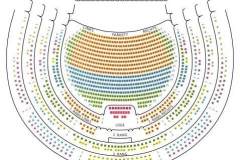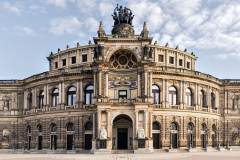Romeo and Juliet
Mo | Tu | We | Th | Fr | Sa | Su |
Romeo and Juliet - Charles Gounod
Opera in five acts
Libretto by Jules Barbier and Michel Carré based on the play of the same name by William Shakespeare
Performed in French with German and English supertitles
Premiere: May 3, 2025
The world’s greatest love story wrapped in enchanting melodies and moving choruses.
Synopsis
Act 1
Overture prologue:
A short chorus sets the scene of the rival families in Verona.
A masked ball in the Capulets’ palace
Tybalt talks to Pâris about Juliette, who appears with her father. Roméo, Mercutio, Benvolio and their friends enter, disguised, and Mercutio sings a ballad about Queen Mab, after which Juliette sings a joyful waltz song. The first meeting between Roméo and Juliette takes place, and they fall in love. But Tybalt re-appears and suspects that the hastily re-masked Roméo is his rival. While Tybalt wants immediate revenge, Capulet orders that the ball continue.
Act 2
The Capulets' garden
After Roméo's page Stephano has helped his master gain access, he reveals the two young lovers exchanging their vows of love.
Act 3
Scene 1: Laurent's cell
Roméo and Juliette, accompanied by Gertrude, go to the cell, and the wedding takes place. Laurent hopes that reconciliation between the houses of the Montagus and the Capulets may thus take place.
Scene 2: a street near Capulet's palace
Stephano sings to attract the occupants into the street. Gregoire and Stephano skirmish as men from each family appear. The duel is first between Tybalt and Mercutio, who falls dead, and then between Roméo, determined to avenge his comrade, and Tybalt. Tybalt is killed by Roméo, who is banished by the Duke.
Act 4
Juliet's room at dawn
Roméo and Juliette are together and, after a long duet, Roméo departs for exile. Juliette's father comes to remind her of Tybalt's dying wish for Juliette to marry Count Pâris. The friar gives Juliette a draught which will cause her to sleep, so as to appear as if dead and, after being laid in the family tomb, it is planned that Roméo will awaken her and take her away. [A ballet scene in the grand hall of the palace was inserted at this point.]
Act 5
Juliet's tomb
Roméo breaks into the tomb after having taken poison because he believes that Juliette is dead. When she awakes from the friar's potion, the lovers' last duet is heard before the poison takes effect on Roméo. As her bridegroom weakens Juliette stabs herself, to be united with her lover in death.
Program and cast
Juliette: Tuuli Takala
Gertrude: Michal Doron (May 3, 6, 9, 16, 25, 2025), Claude Eichenberger (May 29, June 4, 2025)
Tybalt: Brian Michael Moore
Pâris: Gerrit Illenberger
Capulet: Oleksandr Pushniak
Gregorio: Anton Beliaev
Roméo: Liparit Avetisyan
Stephano: Valerie Eickhoff
Benvolio: Jongwoo Hong
Mercutio: Danylo Matviienko
Frère Laurent: Georg Zeppenfeld
Le Duc de Vérone: Tilmann Rönnebeck
Musical Direction: Robert Jindra
Production: Barbara Wysocka
Stage Design: Barbara Hanicka
Costumes: Julia Kornacka
Lighting: Fabio Antoci
Chorus: Jan Hoffmann
Dramaturgy: Benedikt Stampfli
Sächsischer Staatsopernchor Dresden
Sächsische Staatskapelle Dresden
Semperoper Dresden
The Semperoper is the opera house of the Sächsische Staatsoper Dresden (Saxon State Opera) and the concert hall of the Sächsische Staatskapelle Dresden (Saxon State Orchestra). It is also home to the Semperoper ballet. The building is located near the Elbe River in the historic centre of Dresden, Germany.
The opera house was originally built by the architect Gottfried Semper in 1841. After a devastating fire in 1869, the opera house was rebuilt, partly again by Semper, and completed in 1878. The opera house has a long history of premieres, including major works by Richard Wagner and Richard Strauss.
The first opera house at the location of today's Semperoper was built by the architect Gottfried Semper. It opened on 13 April 1841 with an opera by Carl Maria von Weber. The building style itself is debated among many, as it has features that appear in three styles; Early Renaissance and Baroque, with Corinthian style pillars typical of Greek classical revival. Perhaps the most suitable label for this style would be eclecticism, where influences from many styles are used, a practice most common during this period. Nevertheless, the opera building, Semper's first, is regarded as one of the most beautiful European opera houses.

 EN
EN DE
DE IT
IT FR
FR ES
ES RU
RU JP
JP RO
RO
 Seating plan
Seating plan 